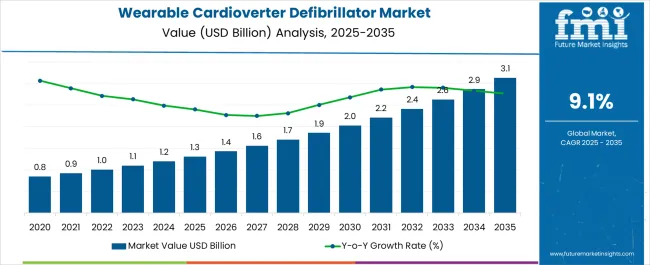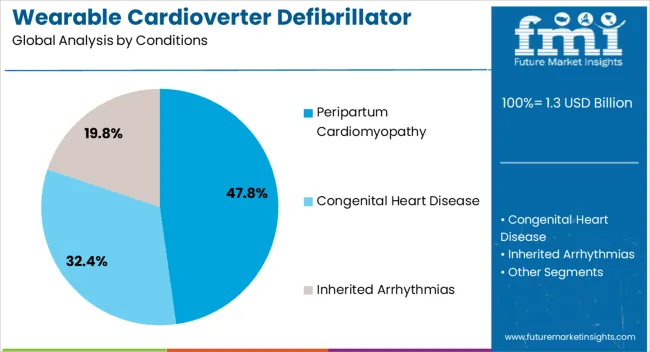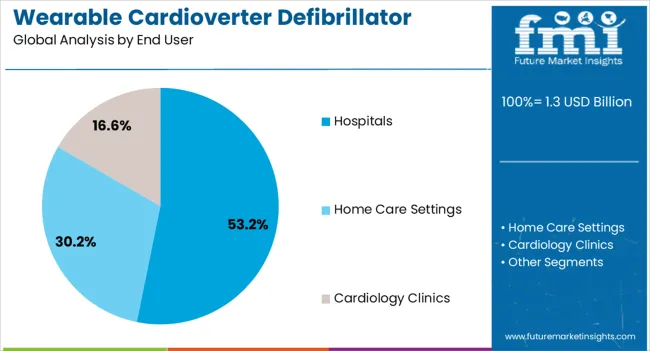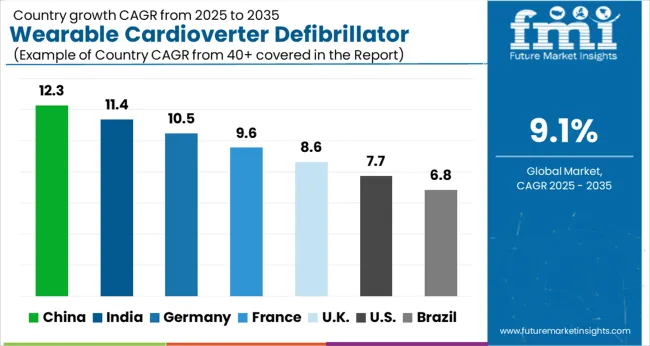The Wearable Cardioverter Defibrillator Market is estimated to be valued at USD 1.3 billion in 2025 and is projected to reach USD 3.1 billion by 2035, registering a compound annual growth rate (CAGR) of 9.1% over the forecast period.

| Metric | Value |
|---|---|
| Wearable Cardioverter Defibrillator Market Estimated Value in (2025 E) | USD 1.3 billion |
| Wearable Cardioverter Defibrillator Market Forecast Value in (2035 F) | USD 3.1 billion |
| Forecast CAGR (2025 to 2035) | 9.1% |
The wearable cardioverter defibrillator market is expanding steadily, supported by its increasing role as a life-saving intervention for patients at high risk of sudden cardiac arrest who may not yet qualify for implantable devices. Demand growth is being influenced by the rising prevalence of cardiovascular conditions, including heart failure, myocardial infarction, and peripartum cardiomyopathy, which have heightened the need for non-invasive and immediate protective solutions.
Technological advancements in device comfort, battery life, and remote monitoring are improving patient compliance and clinical outcomes, reinforcing adoption. Healthcare systems worldwide are emphasizing preventive cardiac care and early intervention strategies, creating favorable conditions for the uptake of wearable defibrillators.
Additionally, growing awareness among patients and physicians about the importance of continuous monitoring and protection in high-risk populations is further supporting market expansion As cardiovascular disease continues to be a leading global health challenge, the wearable cardioverter defibrillator market is expected to see sustained growth, with increased investments in innovation, patient accessibility, and integration into standard cardiac care protocols.
The wearable cardioverter defibrillator market is segmented by conditions, end user, and geographic regions. By conditions, wearable cardioverter defibrillator market is divided into Peripartum Cardiomyopathy, Congenital Heart Disease, and Inherited Arrhythmias. In terms of end user, wearable cardioverter defibrillator market is classified into Hospitals, Home Care Settings, and Cardiology Clinics. Regionally, the wearable cardioverter defibrillator industry is classified into North America, Latin America, Western Europe, Eastern Europe, Balkan & Baltic Countries, Russia & Belarus, Central Asia, East Asia, South Asia & Pacific, and the Middle East & Africa.

The peripartum cardiomyopathy segment is projected to account for 47.8% of the wearable cardioverter defibrillator market revenue share in 2025, making it the leading condition segment. This leadership is being driven by the unique risks associated with peripartum cardiomyopathy, a condition that places women at elevated risk of sudden cardiac arrest during pregnancy and postpartum periods. Wearable defibrillators provide an essential non-invasive protection method during the vulnerable recovery phase when implantable devices are often not considered suitable.
Clinical guidelines and physician practices are increasingly recognizing the role of wearable solutions as a bridge therapy for these patients, ensuring safety until cardiac function stabilizes. Rising awareness campaigns about maternal health and greater access to specialized cardiac care are contributing to increased adoption.
The ability to monitor patients continuously while reducing hospitalization costs is further enhancing uptake in this segment As the prevalence of peripartum cardiomyopathy is increasingly identified through better diagnostics, the demand for wearable cardioverter defibrillators in this condition group is expected to remain strong.

The hospitals segment is anticipated to represent 53.2% of the wearable cardioverter defibrillator market revenue share in 2025, making it the dominant end user category. This dominance is being supported by the critical role hospitals play in initiating therapy for high-risk cardiac patients who require immediate monitoring and protection. Hospitals serve as the primary point of care where wearable defibrillators are prescribed, fitted, and integrated into patient care plans.
Strong emphasis on early cardiac intervention and post-discharge management is driving hospital-based adoption, as healthcare providers prioritize continuous patient safety following acute cardiac events. Increasing patient admissions for cardiovascular complications and growing reliance on non-invasive therapies are reinforcing the importance of hospital-based prescribing.
Additionally, hospitals are leveraging wearable devices as part of broader telehealth and remote monitoring programs, ensuring better follow-up care and adherence With the global burden of cardiovascular diseases rising, hospitals are expected to maintain their leading role in wearable defibrillator adoption, supported by their clinical authority, infrastructure, and integration with comprehensive cardiac treatment pathways.
Wearable cardioverter defibrillator is an external defibrillator which is non-invasive it is used to prevent sudden cardiac attack. It has two parts
Sudden cardiac attack happens when there is an issue with the heart's electrical system. The electrical system guides the heart to relax and contract. Condition where there is abnormal rhythm in the ventricles of the heart is Ventricular Fibrillation. If VF occurs, a defibrillator sends an electrical current to the heart which is used to re-start a normal heart rhythm.
Defibrillators are utilized for the treatment of life-threatening heart dysrhythmias, ventricular fibrillation, and ventricular tachycardia. They control irregular heartbeat, prevent heart failure, and treat patients affected by sudden heart failure. Defibrillators can be internal (inside the body) and external (outside the body). The wearable defibrillator is a treatment given for patients who are at high risk for sudden heart failure or sudden cardiac death. Basically the wearable cardioverter defibrillator is used for outpatient.
The global wearable cardioverter defibrillator market is categorized on the basis of condition type, end user and geography. The market is driven by some key factors such as future advancement in technology which help in introducing patient friendly devices by reducing the size and weight of the wearable cardioverter defibrillator, introduction of rental services for wearable cardioverter defibrillators and reducing the cost and making it affordable in developing countries, enhancing patient education and training. Wearable cardioverter defibrillator is used for the conditions like Peripartum Cardiomyopathy, Congenital heart disease and Inherited Arrhythmias.
Factors contributing to the growth of wearable cardioverter defibrillator marketincludes the rise to prevalence of diseases, growing geriatric population, increasing number of training and awareness among the population base results in growth of market, technological advancements to propel the growth of the market, providing producers with future growth opportunities to bolster the growth of the market
However factors such as lack of knowledge about sudden cardiac arrest, problems related to the use of wearable cardioverter defibrillator devices, and the wearable cardioverter defibrillator does not monitor atrial arrhythmias therefore this hinders the growth of the market
The wearable cardioverter defibrillator market is expected to have tremendous growth during the forecast period (2025-2026), with rising incidence of cardiac disorders, advancement and innovations in technology in medical field, and government initiative by increased spending in research and development
North America holds the largest market share of the overall industry and is liable to keep ruling the business sector asrising incidence of diseases, improvement in healthcare industry and extended growth. USA and Canada contribute to the overall defibrillator market in the region as lot of awareness about the sudden cardiac arrest and defibrillators.
Europe has second largest market for defibrillator devices. The Market is appeared to be driven by increase in demand from emerging countries in the Asia Pacific and Middle East regions, where more workstations and business environments are introducing advancement in defibrillators. It is estimated to benefit the defibrillators market in upcoming years
The report is a compilation of first-hand information, qualitative and quantitative assessment by industry analysts, inputs from industry experts and industry participants across the value chain. The report provides in-depth analysis of parent market trends, macro-economic indicators and governing factors along with market attractiveness as per segments. The report also maps the qualitative impact of various market factors on market segments and geographies.

| Country | CAGR |
|---|---|
| China | 12.3% |
| India | 11.4% |
| Germany | 10.5% |
| France | 9.6% |
| UK | 8.6% |
| USA | 7.7% |
| Brazil | 6.8% |
The Wearable Cardioverter Defibrillator Market is expected to register a CAGR of 9.1% during the forecast period, exhibiting varied country level momentum. China leads with the highest CAGR of 12.3%, followed by India at 11.4%. Developed markets such as Germany, France, and the UK continue to expand steadily, while the USA is likely to grow at consistent rates. Brazil posts the lowest CAGR at 6.8%, yet still underscores a broadly positive trajectory for the global Wearable Cardioverter Defibrillator Market. In 2024, Germany held a dominant revenue in the Western Europe market and is expected to grow with a CAGR of 10.5%. The USA Wearable Cardioverter Defibrillator Market is estimated to be valued at USD 461.9 million in 2025 and is anticipated to reach a valuation of USD 973.0 million by 2035. Sales are projected to rise at a CAGR of 7.7% over the forecast period between 2025 and 2035. While Japan and South Korea markets are estimated to be valued at USD 69.8 million and USD 34.6 million respectively in 2025.
| Item | Value |
|---|---|
| Quantitative Units | USD 1.3 Billion |
| Conditions | Peripartum Cardiomyopathy, Congenital Heart Disease, and Inherited Arrhythmias |
| End User | Hospitals, Home Care Settings, and Cardiology Clinics |
| Regions Covered | North America, Europe, Asia-Pacific, Latin America, Middle East & Africa |
| Country Covered | United States, Canada, Germany, France, United Kingdom, China, Japan, India, Brazil, South Africa |
| Key Companies Profiled | LivaNova PLC, Koninklijke Philips NV, Asahi Kasei Corporation (ZOLL Medical Corporation), Stryker Corporation, Medtronic PLC, Nihon Kohden Corporation, Kestra Medical Technologies Inc., Boston Scientific Corporation, and Element Science Inc. |
The global wearable cardioverter defibrillator market is estimated to be valued at USD 1.3 billion in 2025.
The market size for the wearable cardioverter defibrillator market is projected to reach USD 3.1 billion by 2035.
The wearable cardioverter defibrillator market is expected to grow at a 9.1% CAGR between 2025 and 2035.
The key product types in wearable cardioverter defibrillator market are peripartum cardiomyopathy, congenital heart disease and inherited arrhythmias.
In terms of end user, hospitals segment to command 53.2% share in the wearable cardioverter defibrillator market in 2025.






Our Research Products

The "Full Research Suite" delivers actionable market intel, deep dives on markets or technologies, so clients act faster, cut risk, and unlock growth.

The Leaderboard benchmarks and ranks top vendors, classifying them as Established Leaders, Leading Challengers, or Disruptors & Challengers.

Locates where complements amplify value and substitutes erode it, forecasting net impact by horizon

We deliver granular, decision-grade intel: market sizing, 5-year forecasts, pricing, adoption, usage, revenue, and operational KPIs—plus competitor tracking, regulation, and value chains—across 60 countries broadly.

Spot the shifts before they hit your P&L. We track inflection points, adoption curves, pricing moves, and ecosystem plays to show where demand is heading, why it is changing, and what to do next across high-growth markets and disruptive tech

Real-time reads of user behavior. We track shifting priorities, perceptions of today’s and next-gen services, and provider experience, then pace how fast tech moves from trial to adoption, blending buyer, consumer, and channel inputs with social signals (#WhySwitch, #UX).

Partner with our analyst team to build a custom report designed around your business priorities. From analysing market trends to assessing competitors or crafting bespoke datasets, we tailor insights to your needs.
Supplier Intelligence
Discovery & Profiling
Capacity & Footprint
Performance & Risk
Compliance & Governance
Commercial Readiness
Who Supplies Whom
Scorecards & Shortlists
Playbooks & Docs
Category Intelligence
Definition & Scope
Demand & Use Cases
Cost Drivers
Market Structure
Supply Chain Map
Trade & Policy
Operating Norms
Deliverables
Buyer Intelligence
Account Basics
Spend & Scope
Procurement Model
Vendor Requirements
Terms & Policies
Entry Strategy
Pain Points & Triggers
Outputs
Pricing Analysis
Benchmarks
Trends
Should-Cost
Indexation
Landed Cost
Commercial Terms
Deliverables
Brand Analysis
Positioning & Value Prop
Share & Presence
Customer Evidence
Go-to-Market
Digital & Reputation
Compliance & Trust
KPIs & Gaps
Outputs
Full Research Suite comprises of:
Market outlook & trends analysis
Interviews & case studies
Strategic recommendations
Vendor profiles & capabilities analysis
5-year forecasts
8 regions and 60+ country-level data splits
Market segment data splits
12 months of continuous data updates
DELIVERED AS:
PDF EXCEL ONLINE
Wearable Fall Detector Market Size and Share Forecast Outlook 2025 to 2035
Wearable Industrial Exoskeleton Devices Market Size and Share Forecast Outlook 2025 to 2035
Wearable Healthcare Devices Market Size and Share Forecast Outlook 2025 to 2035
Wearable Sensor Market Size and Share Forecast Outlook 2025 to 2035
Wearable Sleep Tracker Market Forecast and Outlook 2025 to 2035
Wearable Medical Device Market Size and Share Forecast Outlook 2025 to 2035
Wearable Injectors Market Size and Share Forecast Outlook 2025 to 2035
Wearable Fitness Tracker Market Size and Share Forecast Outlook 2025 to 2035
Wearable Translator Market Size and Share Forecast Outlook 2025 to 2035
Wearable Electronics Market Size and Share Forecast Outlook 2025 to 2035
Wearable Band Market Size and Share Forecast Outlook 2025 to 2035
Wearable Gaming Technology Market Size and Share Forecast Outlook 2025 to 2035
Wearable Beauty Market Size, Growth, and Forecast for 2025 to 2035
Wearable Medical Robots Market - Trends & Forecast 2025 to 2035
Wearable Computing Market Trends – Growth & Forecast 2025 to 2035
Wearable Blood Pressure Monitor Market Trends and Forecast 2025 to 2035
Wearable Pregnancy Devices Market Trends and Forecast 2025 to 2035
Wearable Fitness Technology Market Insights - Trends & Forecast 2025 to 2035
Wearable Computing Devices Market Analysis - Size, Share & Forecast 2025 to 2035
Wearable Glucometers Market

Thank you!
You will receive an email from our Business Development Manager. Please be sure to check your SPAM/JUNK folder too.
Chat With
MaRIA